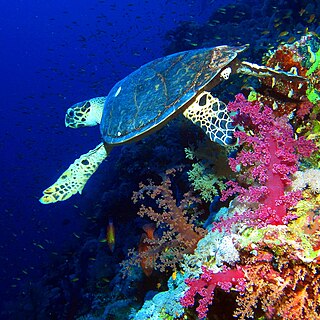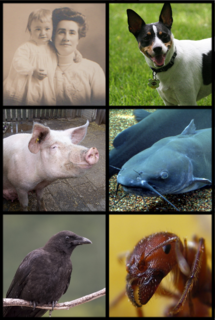Related Research Articles

A herbivore is an animal anatomically and physiologically adapted to eating plant material, for example foliage or marine algae, for the main component of its diet. As a result of their plant diet, herbivorous animals typically have mouthparts adapted to rasping or grinding. Horses and other herbivores have wide flat teeth that are adapted to grinding grass, tree bark, and other tough plant material.

Predation is a biological interaction where one organism, the predator, kills and eats another organism, its prey. It is one of a family of common feeding behaviours that includes parasitism and micropredation and parasitoidism. It is distinct from scavenging on dead prey, though many predators also scavenge; it overlaps with herbivory, as seed predators and destructive frugivores are predators.

Hemiptera is an order of insects, commonly called true bugs, comprising over 80,000 species within groups such as the cicadas, aphids, planthoppers, leafhoppers, bed bugs, and shield bugs. They range in size from 1 mm (0.04 in) to around 15 cm (6 in), and share a common arrangement of sucking mouthparts. The name "true bugs" is often limited to the suborder Heteroptera. Many insects commonly known as "bugs", especially in American English, belong to other orders; for example, the lovebug is a fly and the May bug and ladybug are beetles.

In biology and medicine, a host is a larger organism that harbours a smaller organism; whether a parasitic, a mutualistic, or a commensalist guest (symbiont). The guest is typically provided with nourishment and shelter. Examples include animals playing host to parasitic worms, cells harbouring pathogenic (disease-causing) viruses, a bean plant hosting mutualistic (helpful) nitrogen-fixing bacteria. More specifically in botany, a host plant supplies food resources to micropredators, which have an evolutionarily stable relationship with their hosts similar to ectoparasitism. The host range is the collection of hosts that an organism can use as a partner.
In animal dormancy, diapause is the delay in development in response to regularly and recurring periods of adverse environmental conditions. It is a physiological state with very specific initiating and inhibiting conditions. The mechanism is a means of surviving predictable, unfavorable environmental conditions, such as temperature extremes, drought, or reduced food availability. Diapause is observed in all the life stages of arthropods, especially insects. Embryonic diapause, a somewhat similar phenomenon, occurs in over 130 species of mammals, possibly even in humans, and in the embryos of many of the oviparous species of fish in the order Cyprinodontiformes.

Frass refers loosely to the more or less solid excreta of insects, and to certain other related matter.

Entomophagy describes a feeding behaviour that includes insects. Aside from non-human creatures, the term can also refer to the practice of eating insects among humans.
A generalist species is able to thrive in a wide variety of environmental conditions and can make use of a variety of different resources. A specialist species can thrive only in a narrow range of environmental conditions or has a limited diet. Most organisms do not all fit neatly into either group, however. Some species are highly specialized, others less so, and some can tolerate many different environments. In other words, there is a continuum from highly specialized to broadly generalist species.

An ecological pyramid is a graphical representation designed to show the biomass or bioproductivity at each trophic level in a given ecosystem.
Herbivores are dependent on plants for food, and have coevolved mechanisms to obtain this food despite the evolution of a diverse arsenal of plant defenses against herbivory. Herbivore adaptations to plant defense have been likened to "offensive traits" and consist of those traits that allow for increased feeding and use of a host. Plants, on the other hand, protect their resources for use in growth and reproduction, by limiting the ability of herbivores to eat them. Relationships between herbivores and their host plants often results in reciprocal evolutionary change. When a herbivore eats a plant it selects for plants that can mount a defensive response, whether the response is incorporated biochemically or physically, or induced as a counterattack. In cases where this relationship demonstrates "specificity", and "reciprocity", the species are thought to have coevolved. The escape and radiation mechanisms for coevolution, presents the idea that adaptations in herbivores and their host plants, has been the driving force behind speciation. The coevolution that occurs between plants and herbivores that ultimately results in the speciation of both can be further explained by the Red Queen hypothesis. This hypothesis states that competitive success and failure evolve back and forth through organizational learning. The act of an organism facing competition with another organism ultimately leads to an increase in the organism's performance due to selection. This increase in competitive success then forces the competing organism to increase its performance through selection as well, thus creating an "arms race" between the two species. Herbivores evolve due to plant defenses because plants must increase their competitive performance first due to herbivore competitive success.

A spongivore is an animal anatomically and physiologically adapted to eating animals of the phylum Porifera, commonly called sea sponges, for the main component of its diet. As a result of their diet, spongivore animals like the hawksbill turtle have developed sharp, narrow bird-like beak that allows them to reach within crevices on the reef to obtain sponges.

In ecology, a community is a group or association of populations of two or more different species occupying the same geographical area at the same time, also known as a biocoenosis, biotic community, biological community, ecological community, or life assemblage. The term community has a variety of uses. In its simplest form it refers to groups of organisms in a specific place or time, for example, "the fish community of Lake Ontario before industrialization".

The trophic level of an organism is the position it occupies in a food web. A food chain is a succession of organisms that eat other organisms and may, in turn, be eaten themselves. The trophic level of an organism is the number of steps it is from the start of the chain. A food web starts at trophic level 1 with primary producers such as plants, can move to herbivores at level 2, carnivores at level 3 or higher, and typically finish with apex predators at level 4 or 5. The path along the chain can form either a one-way flow or a food "web". Ecological communities with higher biodiversity form more complex trophic paths.

Insect ecology is the scientific study of how insects, individually or as a community, interact with the surrounding environment or ecosystem.

An omnivore is an animal that has the ability to eat and survive on both plant and animal matter. Obtaining energy and nutrients from plant and animal matter, omnivores digest carbohydrates, protein, fat, and fiber, and metabolize the nutrients and energy of the sources absorbed. Often, they have the ability to incorporate food sources such as algae, fungi, and bacteria into their diet.
A consumer in a food chain is a living creature that eats organisms from a different population. A consumer is a heterotroph and a producer is an autotroph. Both are organisms that obtain energy from other living things... Like sea angels, they take in organic moles by consuming other organisms, so they are commonly called consumers. Heterotrophs can be classified by what they usually eat as herbivores, carnivores, omnivores, or decomposers. On the other hand, autotrophs are organisms that use energy directly from the sun or from chemical bonds. Autotrophs are vital to all ecosystems because all organisms need organic molecules, and only autotrophs can produce them from inorganic compounds. Autotrophs are classified as either photoautotrophs or chemoautotrophs.

Halobates or sea skaters are a genus with over 40 species of water striders. Most Halobates species are coastal and typically found in sheltered marine habitats, but five live on the surface of the open ocean and only occur near the coast when storms blow them ashore. These are the only known truly oceanic, offshore insects. They are found in tropical and subtropical marine habitats around the world, with a single species recorded in rivers a few kilometers upstream from the ocean. Halobates are generally very common.

Egg predation is a feeding strategy by animals (ovivores) including fish, birds, snakes and insects, in which they consume the eggs of other species. Since an egg represents a complete organism at one stage of its life cycle, eating an egg is a form of predation, the killing of another organism for food.

Grazing is a method of feeding in which a herbivore feeds on low-growing plants such as grasses or other multicellular organisms, such as algae. Many species of animals can be said to be grazers, from large animals such as hippopotamuses to small aquatic snails. Grazing behaviour is a type of feeding strategy within the ecology of a species. Specific grazing strategies include graminivory ; coprophagy ; pseudoruminant ; and grazing on plants other than grass, such as on marine algae.
References
- Huffaker, Carl B. & Gutierrez, A. P. (1999). Ecological Entomology. 2nd Edition (illustrated). John Wiley and Sons. ISBN 0-471-24483-X, ISBN 978-0-471-24483-7. Limited preview on Google Books. Accessed 9 January 2010.
- Rogers, C. N.; Steinberg, P. D. & de Nys, R. (1994). "Factors associated with oligophagy in two species of sea hares (Mollusca: Anaspidea)". Journal of Experimental Marine Biology and Ecology, Volume 192, Issue 1, 17 October 1995, Pages 47–73. doi : 10.1016/0022-0981(95)00057-X.
| Look up oligophagy in Wiktionary, the free dictionary. |